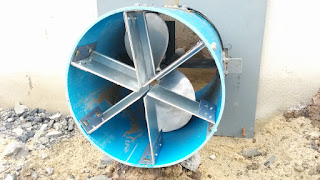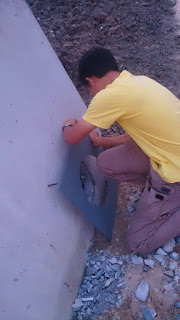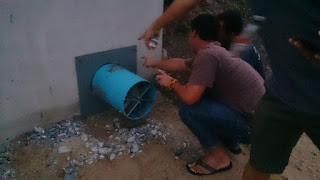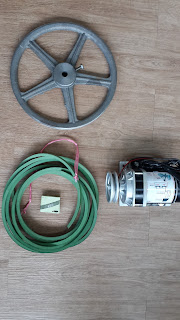We’ve made some progress in figuring out how to get the circulation pumps mounted into the cement cisterns. All three pumps have been constructed, with the long-tail boat propeller shafts cut down to the right size, the mounting brackets welded onto them, and all of that mounted into a short piece of 12″ PVC pipe.
Here is a close-up:
It isn’t mounted all the way in yet, but the idea is that the L brackets on the PVC will bolt into the metal plate, which will itself bolt into studs coming out of the cement. We are still working on how to secure the studs so they don’t come out when we are mounting or unmounting the pump. The idea is that the whole plate and pump assembly will be able to be unbolted under water and then removed for maintenance every few years. I’ve never tried to tighten a nut 100-150cm under water before, so we are thinking long and hard about how to make this process as simple and reliable as possible. Also, most of it probably has to be performed by one person with only one arm free (assuming the other arm is being used to brace yourself in the water).
Here are a few pictures from last night showing them working out some of the details:
The next step will be to mount the belt and pulleys to the back side of the cement cistern and mount the motor to the top of it (out of the water). We have gone with a 24V 450W electric motor (locally sourced, but imported from China). It has a built-in 5:1 gearbox resulting in a nominal drive speed of about 550RPM. My target would be to then drop it down again by between 2.5:1 and 5:1 on the belt and pulley to result in an impeller speed of between 110-220RPM.
Here is a picture of the motor, pulleys, and belt that we bought for first test:
I’m beginning to wonder whether it would be better to close up the gaps in the larger pulley so that it has less resistance when spinning underwater, or whether that will restrict the water flow into the back of the pump too much. This might be too much work to do anyway. Maybe I’ll just live with the extra loss for now.
It is also important for the vee belt (green in the picture above) to be able to handle sitting in the water all of the time. I have even heard of kevlar reinforced ones, but that is probably overkill for my application. Anyway, if I have to replace the belt once a year or so, that is probably not too much of a hassle. I think that this issue will require some more testing to see if we need to do anything special or not.




